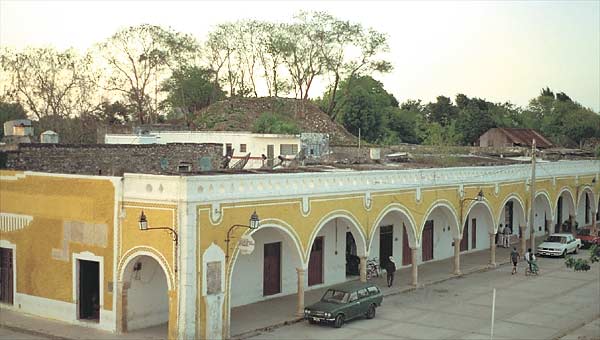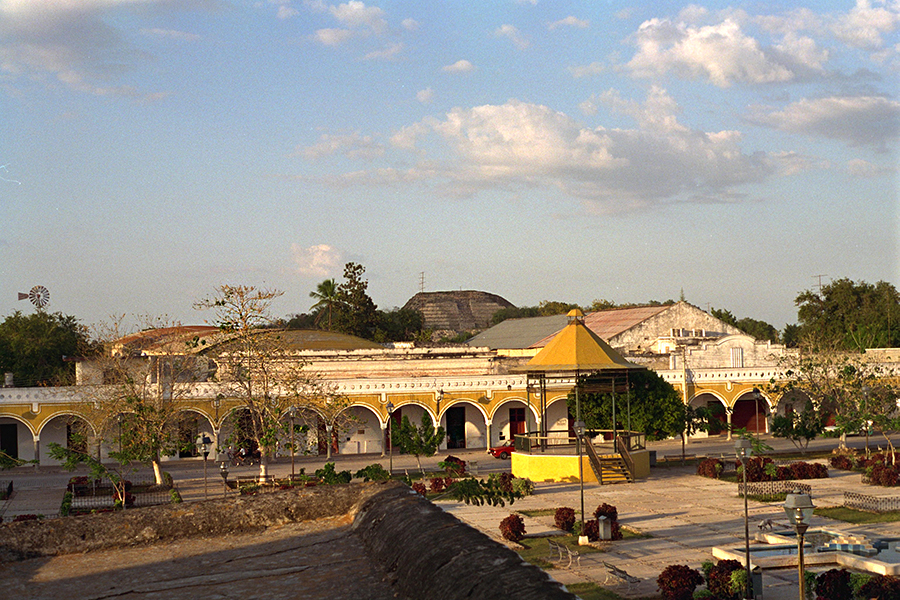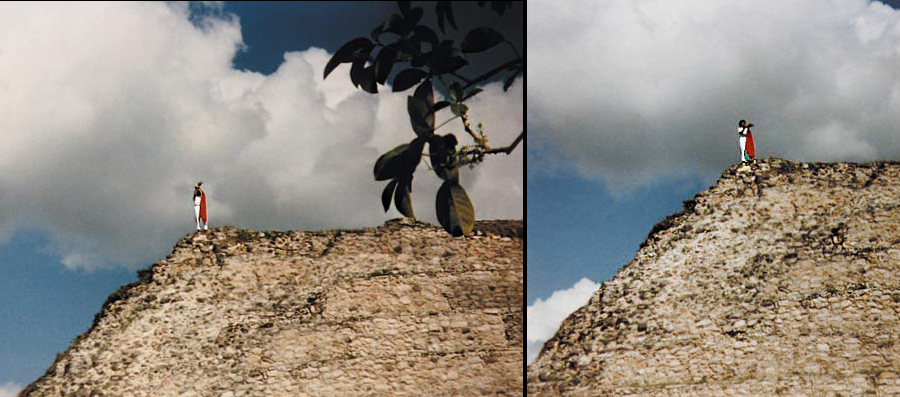Izamal: Superimposition of Catholicism & Spanish culture on top of Maya tradition


NEW! Subscribe to our free newsletter, MayaRuins Insights
Our annotated reading list on The History of Izamal
Our annotated reading list on The Arrival of the Spanish
In Izamal, more than anywhere else in the Yucatan, the superimposition of Catholicism and Spanish culture on top of Mayan tradition is visible.
Long before the Spanish arrived, Izamal had been a prosperous ancient city, occupied continuously from the late Pre-classic period onwards (from about 300 BC). Twelve large pyramids made the city one of the most impressive in Yucatan. Chief among them was the giant pyramid Kinich Kak Mo.
Izamal was dedicated to the worship of Itzamna, patron of learning, science, and the arts, who was also associated with healing and medicine as well.
Already established as a major pilgrimage center for the Maya, it was converted to a Christian pilgrimage site by the Franciscan order after they arrived in 1549 by the construction of the gigantic Basilica of San Antonio de Padua on top of the older pyramids.

See this interactive drone view of modern Izamal, where you can still make out three of the four pyramids that defined the heart of the ancient city. The Basilica occupies the site of the former P'ap'hol-chaak, the home of Chaac. To the east rises the huge mound and temple of Kinich Kak Mo, slightly to the north is probably Humpictok ("Master of a Thousand Flints").
In 1841, the diplomat, explorer & travel writer John Lloyd Stephens recounted:
"Two or three streets distant from the plaza, but visible in all its huge proportions, was the most stupendous mound we had seen in the country, being perhaps, six or seven hundred feet long and sixty feet high, which we ascertained beyond all doubt, had interior chambers."
Stephens, John Lloyd. Incidents of Travel in Yucatan. Illustrated by Frederick Catherwood. Dover Publication, Inc. New York 1963, Volume Two, p. 298.
The center of the ancient city of Izamal was dominated by four huge pyramids. In Maya Missions, Rosalind and Richard Perry write:
"Oriented to the cardinal directions around a huge plazza, four great pyramids dominated the heart of the city. The largest, called Papolchac or "House of Heads and Lightening," featured a high, elegant temple faced with gigantic stone reliefs. Elevated on a huge platform and reached by a broad stairway of fifty steps, it was chosen by the friars for their mission site.
Facing Papolchac with Kinich–Kakmo ("Sun's Face with Fiery Rays"), the only surviving pyramid and still an imposing mound, although battered and overgrown. The other two pyramids, Kab–ul ("Mighty Hand") and Humpictok ("Master of a Thousand Flints") have been razed."
Rosalind and Richard Perry, Maya Missions: Exploring the Spanish Colonial Churches of Yucatan. Espadaña Press. Santa Barbara 1988, p 201-202

Known also as The City of Three Cultures, Izamal represents both the collision and assimilation of the cultures that shaped the Yucatan.
The superimposition of Catholicism and Spanish culture is visible in stone -- the ancient pyramids lie among the downtown blocks, incorporated into the modern town.

When the Spanish arrived, four great pyramids oriented to the four cardinal directions dominated the city. The pyramid Hunpictok ("Master of a Thousand Flints") was famous for its stucco masks
This etching of a now-destroyed stucco mask was made by Frederick Catherwood, who accompanied Stephen on his travels through Yucatan & Central America. Stephens writes:
"One of these great mounds, having at that time benches upon it, commanding a view of the bull-fight in the plaza, blocked up the yard of the house we occupied, and extended into the adjoining yard of the Senora Mendez, who was the owner of both. It is, perhaps, two hundred feet long and thirty high.
The part in our yard was entirely ruined, but in that of the senora it appeared that its vast sides had been covered from one end to the other with colossal ornaments in stucco, most of which had fallen, but among the fragments is the gigantic head represented. It is seven feet eight inches in height and seven feet in width. The ground-work is of projecting stones, which are covered with stucco.
A stone one foot six inches long protrudes from the chin, intended, perhaps, for burning copal on, as a sort of altar. It was the first time we had seen an ornament of this kind upon the exterior of any of these structures. In sternness and harshness of expression it reminded us of the idols of Copan, and its colossal proportions, with the corresponding dimensions of the mound, gave an unusual impression of grandeur."
Stephens, John Lloyd. Incidents of Travel in Yucatan. Illustrated by Frederick Catherwood. Dover Publication, Inc. New York 1963, Volume Two, p. 297.
NB: This stucco relief no longer exists, the only record of its former existence being Catherwood's etching and an illustration by Désiré Charnay from the 19th century.

Stephens' & Catherwood's arrival in Izamal coincided with the celebration of a fiesta:
"Amid this gay scene the eye turned involuntarily to immense mounds rising grandly above the tops of the houses, from which the whole city had been built, without seeming to diminish their colossal proportions, proclaiming the power of those who reared them, and destined apparently to stand when the feebler structures of their more civilized conquerors shall have crumbled into dust."
Stephens, John Lloyd. Incidents of Travel in Yucatan. Illustrated by Frederick Catherwood. Dover Publication, Inc. New York 1963, Volume Two, p. 297.

Photo courtesy of Marion Canavan
What seems to be a field of weeds in the foreground, is actually the first platform level of the pyramid of Kinich Kak Mo, which has been translated as "Fiery Sun's Face" or "Fire Macaw — Face of the Sun". According to legend, offerings left on the pyramid were collected by the god Itzamna, in the form of a macaw.
The base measures 200 meters, and rises 36 meters. With a volume of 700,000 cubic meters, this is the largest structure on the Yucatan Peninsula. A smaller 10 tiered pyramid rises from the platform.
Coe, Andrew. Archaeological Mexico: A Guide to Ancient Cities and Sacred Sites. Avalon Travel Publishing, Inc. Emeryville California 2001. 2nd Edition, p. 331.

Marion, on one of her visits, was privileged to witness the performance of a Maya ceremony atop Kinich Kaka Mo
The Maya retain a clear vision of their ancient way, living in harmony with Nature, keeping time with the rhythms of the seasons.
Traditional knowledge is activated by costumbres (customs) handed down from generation to generation -- formulas for living and thinking as a Maya. Costumbres give meaning to life; the sense of being a special people placed at the center of the world.
Nature and the ancient ruins remain sacred books, calling softly with the voice of many thousands of years.